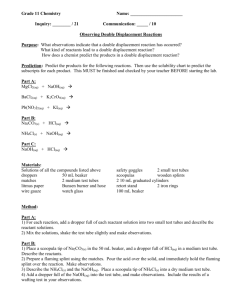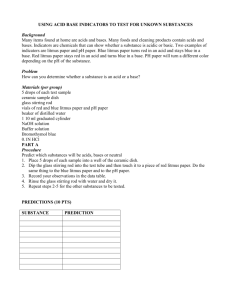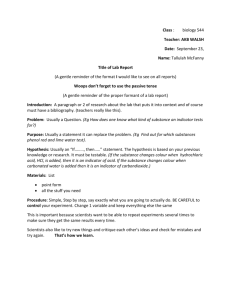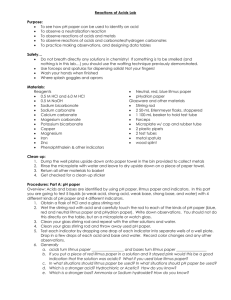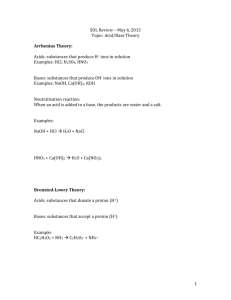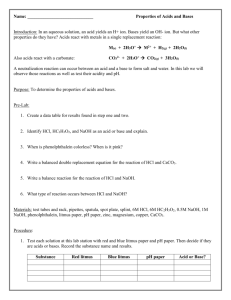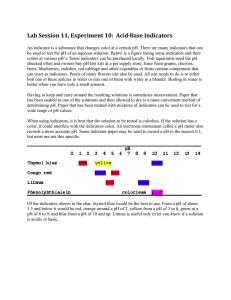pH of Common Substances Lab
advertisement
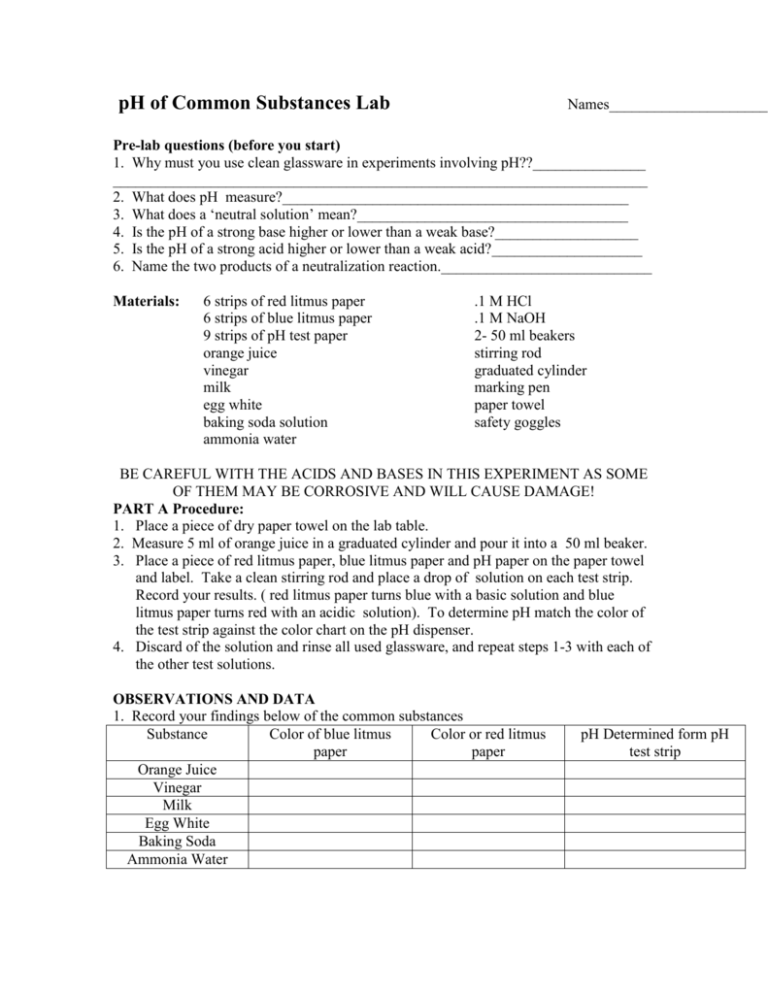
pH of Common Substances Lab Names_____________________ Pre-lab questions (before you start) 1. Why must you use clean glassware in experiments involving pH??_______________ _______________________________________________________________________ 2. What does pH measure?______________________________________________ 3. What does a ‘neutral solution’ mean?____________________________________ 4. Is the pH of a strong base higher or lower than a weak base?___________________ 5. Is the pH of a strong acid higher or lower than a weak acid?____________________ 6. Name the two products of a neutralization reaction.____________________________ Materials: 6 strips of red litmus paper 6 strips of blue litmus paper 9 strips of pH test paper orange juice vinegar milk egg white baking soda solution ammonia water .1 M HCl .1 M NaOH 2- 50 ml beakers stirring rod graduated cylinder marking pen paper towel safety goggles BE CAREFUL WITH THE ACIDS AND BASES IN THIS EXPERIMENT AS SOME OF THEM MAY BE CORROSIVE AND WILL CAUSE DAMAGE! PART A Procedure: 1. Place a piece of dry paper towel on the lab table. 2. Measure 5 ml of orange juice in a graduated cylinder and pour it into a 50 ml beaker. 3. Place a piece of red litmus paper, blue litmus paper and pH paper on the paper towel and label. Take a clean stirring rod and place a drop of solution on each test strip. Record your results. ( red litmus paper turns blue with a basic solution and blue litmus paper turns red with an acidic solution). To determine pH match the color of the test strip against the color chart on the pH dispenser. 4. Discard of the solution and rinse all used glassware, and repeat steps 1-3 with each of the other test solutions. OBSERVATIONS AND DATA 1. Record your findings below of the common substances Substance Color of blue litmus Color or red litmus paper paper Orange Juice Vinegar Milk Egg White Baking Soda Ammonia Water pH Determined form pH test strip 2. Using the data from number 1, place each substance on the graph below where it belongs according to its’ pH. 0 1 2 3 4 5 6 7 8 9 10 11 12 13 14 Strong…………………..weak………………………….neutral………………………...weak…………………………..strong Base base acid acid 3. Which of the test solutions were acidic?_________________________________________ 4. Which of the test solutions were basic?__________________________________________ 5. What is the strongest acid?_________________________________________ 6. What is the strongest base?_________________________________________ 7. What would you select in a separate investigation to be your best indicator and why?_______ ______________________________________________________________________________ Part B Procedure 1. Now measure 10 ml of .1 M HCl in a graduated cylinder and put it in a 50 ml beaker, by placing a test pH strip on the paper towel measure the pH of the HCl. 2. Repeat step 5 using the NaOH and a separate 50 ml beaker. 3. Mix the HCl with the NaOH and stir with the stirring rod into either beaker. 4. Using the stirring rod place one drop of the mixture on a fresh pH test strip and record your pH. 5. Depending on your pH, you will need to either add more NaOH or HCl until you have neutralized the solution. Using the dropper bottles do this and record the number of drops in the space provided. 6. Clean up all test strips, and glassware, return to tray. Wash hands with soap and water. OBSERVATIONS AND DATA 1. Characteristics of the substances Substance pH HCl NaOH HCl + NaOH 2. Based on your results, you will have to add drops of either HCl or NaOH, what did you have to add_____________________________ 3, How many drops did it take for you to reach a neutral solution?________________ 4. What would remain in the beaker if we let it sit out for a week and allowed the solution to evaporate?_______________________ 5. If your pH was not neutral, explain why this happened. If you did get a neutral pH the first time explain why you believe it happened?_________________________________ _______________________________________________________________________

